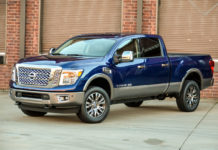Toyota’s RAV4 owns the distinction of being the first bite-size sport-utility vehicle. The RAV4 debuted in 1996 when most SUVs were still unwieldy, body-on-frame beasts. In contrast, the car-based Toyota was small and easy to drive. That it was shaped like a jelly bean hardly seemed to matter. With plenty of sales success behind it, it gave rise to a whole new segment of vehicles often called mini-utes or cute-utes.
Like its modern-day competitors, the 2007 Toyota RAV4 isn’t so mini anymore. It’s still manageably sized and practical for city use, but now there’s room for a V6 engine and a third-row seat — features that would have been unimaginable in the original. During its last redesign in 2006, the vehicle saw the most dramatic changes of its decade-long history. It moved to a new platform with a 7-inch-longer wheelbase, and overall length increased by a whopping 2 feet. Not only did this give Toyota’s compact SUV a more substantial, less toy-like look on the outside, it opened up 4 more inches of legroom in the second row and 8 more cubic feet of luggage space.
The previous-generation RAV4’s 2.4-liter four-cylinder engine carried over and continues to provide adequate motivation for what’s now a 3,400-pound vehicle. However, in an effort to attract power-hungry buyers with more flexible budgets, Toyota also slotted a new 3.5-liter V6 into the lineup. The V6 is good for an amazing 269 horsepower and still gives the four-wheel-drive RAV4 a 21/28 mpg rating.
Even with its heftier size, the current RAV4 continues to provide the sharp handling dynamics that made earlier models so popular. While the Mazda CX-7 surpasses it in this regard, the Toyota is still one of the most entertaining SUVs available for less than $30,000. It’s also an excellent, all-around choice for singles, couples and young families shopping for a versatile utility vehicle. Other candidates you may want to consider, along with the CX-7, include the Chevrolet Equinox, Ford Escape, Honda CR-V, Hyundai Santa Fe and Mitsubishi Outlander. Of this group, the Honda is the most refined, while the larger Hyundai offers a true midsize-SUV experience for a compact price. The Mitsubishi is the closest match in size and amenities, but even with its new V6, it’s not as quick as the RAV4.
In fact, no SUV in this price range can match the straight-line performance of the V6-equipped 2007 Toyota RAV4 — an advantage that will continue to set this well-rounded compact SUV apart from competitors more focused on utility than fun.
A compact four-door SUV, the 2007 Toyota RAV4 is available in three trim levels: base, Sport and Limited. Standard features for the base RAV4 include 16-inch steel wheels (17s on V6 models), privacy glass, a tilt-and-telescoping steering wheel, air-conditioning, an MP3/WMA-capable CD stereo with an MP3 player jack, cruise control, full power accessories and three 12-volt power points. To this, the Sport adds 18-inch alloy wheels, a sport-tuned suspension, slightly quicker steering, fender flares, color-keyed door handles, a roof rack and heated mirrors. The top-of-the-line RAV4 Limited sizes down to 17-inch alloy wheels, but offers dual-zone automatic climate control, a power driver seat, a leather-wrapped steering wheel, an in-dash CD changer, power-folding mirrors and a body-color spare tire cover.
A third-row seat is optional on all trim levels, while Sport and Limited models can be equipped with a nine-speaker JBL sound system (with Bluetooth capability built in) and a moonroof. Heated leather seats and a DVD-based rear entertainment system are exclusive options for the Limited.
Powertrains and Performance
A 2.4-liter, four-cylinder engine is standard on all trim levels, and it delivers 166 hp and 165 pound-feet of torque. A 3.5-liter V6, which boasts 269 hp and 246 lb-ft of torque, is optional across the board. Automatic transmissions are standard — the four-cylinder gets paired with a four-speed automatic, while the V6 gets a five-speed unit. All versions of the Toyota RAV4 are available with either front-wheel drive or four-wheel drive (4WD). Front-drive models have a limited-slip differential. The electronic 4WD system sends most of the power to the front wheels until it identifies potential slippage. It also has a “4WD lock” mode that fixes the front/rear power split at 50/50, which is useful for driving in snow. Fuel economy is impressive, as all models have an EPA combined mpg rating in the mid 20s. Towing preparation is available on V6-equipped RAV4s, and thusly equipped, the compact sport-ute can pull up to 3,500 pounds.
Safety
Antilock disc brakes, stability control, traction control, front-seat side airbags and full-length side curtain airbags are standard on every 2007 Toyota RAV4. Vehicles equipped with the V6 and/or the optional third-row seat also come with hill-start assist and downhill assist control. In NHTSA crash tests, the RAV4 earned a perfect five stars for driver protection in frontal impacts and four stars for the front passenger. It earned five stars for front- and rear-occupant protection in side impacts. Toyota’s small SUV performed extremely well in IIHS tests as well, earning the top rating of “Good” in both the frontal-offset and side-impact crash tests.
Interior Design and Special Features
Inside, the RAV4 has a clean design with large, simple controls and lots of storage space. The cabin isn’t as plasticky as previous-generation RAV4s, but it still has a budget feel compared to competitors like the CR-V and Santa Fe. Nevertheless, the Toyota offers a highly practical design. The rear seats recline, and can slide forward or rearward 6.5 inches to optimize passenger space or cargo capacity. Normal seating capacity is five; the optional third-row seat bumps it to seven, though this seat is truly meant only for children. To configure the RAV4 for cargo, all one has to do is flip a lever to instantly get a flat load floor — no need to remove headrests or fold up seat cushions. With its flat load floor, the RAV4 can hold a maximum of 73 cubic feet of cargo. The load floor is also quite low for this class, and minimizes the strain of loading a week’s worth of groceries. The Toyota’s side-hinged tailgate can be an inconvenience when you’re parked on the street, though, as it opens away from the curb.
Driving Impressions
Intended for a life on pavement, the 2007 Toyota RAV4 really shines in this environment. Its taut suspension and quick steering make daily errands much more enjoyable than they would be in most SUVs. It’s not as athletic as the CX-7, but in trade, the Toyota offers a smooth ride that’s forgiving enough for commuters who drive on crumbling expressways. Road noise can be an issue at times, but wind noise is well controlled. The four-cylinder engine is a reasonable choice for most buyers, as it provides adequate power for day-to-day driving. The optional 269-hp V6, meanwhile, is full of swagger. So equipped, the RAV4 can embarrass quite a few modern sport coupes in terms of acceleration.
| Exterior | |
| Length: 181.1 in. | Width: 71.5 in. |
| Height: 66.3 in. | Wheel Base: 104.7 in. |
| Ground Clearance: 7.5 in. | Curb Weight: 3300 lbs. |
| Gross Weight: 4430 lbs. | |
| Interior | |
| Front Head Room: 40.8 in. | Front Hip Room: 53.8 in. |
| Front Shoulder Room: 57.1 in. | Rear Head Room: 39.7 in. |
| Rear Shoulder Room: 55.3 in. | Rear Hip Room: 52.4 in. |
| Front Leg Room: 41.8 in. | Rear Leg Room: 38.3 in. |
| Luggage Capacity: 37.2 cu. ft. | Maximum Cargo Capacity: 73 cu. ft. |
| Maximum Seating: 7 | |
| Performance | |
| Base Number of Cylinders: 4 | Base Engine Size: 2.4 liters |
| Base Engine Type: Inline 4 | Horsepower: 166 hp |
| Max Horsepower: 6000 rpm | Torque: 165 ft-lbs. |
| Max Torque: 4000 rpm | Maximum Payload: 1130 lbs. |
| Maximum Towing Capacity: 1500 lbs. | Drive Type: FWD |
| Turning Circle: 34.8 ft. | |
| Fuel | |
| Fuel Tank Capacity: 15.9 gal. | |
| EPA Mileage Estimates: (City/Highway) | |
| Automatic: : 24 mpg / 30 mpg | |
| Range in Miles: (City/Highway) | |
| Automatic: 381.6 mi. / 477 mi. | |
Source: Toyota Via Edmunds








